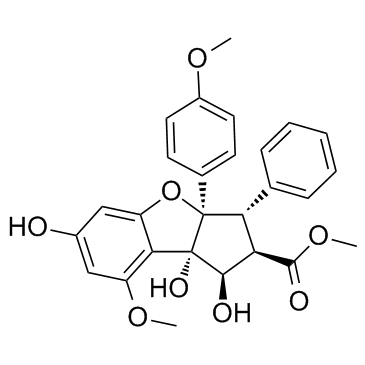Silvestrol aglycone
Modify Date: 2024-01-06 18:14:55

Silvestrol aglycone structure
|
Common Name | Silvestrol aglycone | ||
|---|---|---|---|---|
| CAS Number | 960365-65-5 | Molecular Weight | 478.49100 | |
| Density | N/A | Boiling Point | N/A | |
| Molecular Formula | C27H26O8 | Melting Point | N/A | |
| MSDS | N/A | Flash Point | N/A | |
Use of Silvestrol aglyconeSilvestrol aglycone, a aglycone of potential anticancer rocaglate derivative from Aglaia foveolata, induces apoptosis in LNCaP cells through the mitochondrial/apoptosome pathway without activation of executioner caspase-3 or -7; 5'myc-UTR-LUC inhibtior (IC50= 0.8 nM).IC50 value:Target: Apoptosis inducerin vitro: Silvestrol induced an apoptotic response, disrupted the mitochondrial trans-membrane potential and caused cytochrome c release into the cytoplasm. Immunoblot analysis indicated that, at the protein level, silvestrol produced an increase of Bcl-xl phosphorylation with a concomitant increase of bak. Furthermore, caspase-2, -9 and -10 appeared to be involved in silvestrol-mediated apoptosis. In contrast, the involvement of caspase-3 and -7 was not detected, either by immunoblot or caspase-3/-7-like activity analysis, indicating that these pathways do not play a crucial role in silvestrol-induced apoptosis [1]. The ability of silvestrol and analogues to selectively inhibit the translation of proteins with high requirement on the translation-initiation machinery (i.e., complex 5'-untranslated region UTR) relative to simple 5'UTR was determined by a cellular reporter assay. Simplified analogues of silvestrol such as compounds 74 and 76 were shown to have similar cytotoxic potency and better ADME characteristics relative to those of silvestrol [2].in vivo: |
| Name | methyl (1R,2R,3S,3aR,8bS)-1,6,8b-trihydroxy-8-methoxy-3a-(4-methoxyphenyl)-3-phenyl-2,3-dihydro-1H-cyclopenta[b][1]benzofuran-2-carboxylate |
|---|---|
| Synonym | More Synonyms |
| Description | Silvestrol aglycone, a aglycone of potential anticancer rocaglate derivative from Aglaia foveolata, induces apoptosis in LNCaP cells through the mitochondrial/apoptosome pathway without activation of executioner caspase-3 or -7; 5'myc-UTR-LUC inhibtior (IC50= 0.8 nM).IC50 value:Target: Apoptosis inducerin vitro: Silvestrol induced an apoptotic response, disrupted the mitochondrial trans-membrane potential and caused cytochrome c release into the cytoplasm. Immunoblot analysis indicated that, at the protein level, silvestrol produced an increase of Bcl-xl phosphorylation with a concomitant increase of bak. Furthermore, caspase-2, -9 and -10 appeared to be involved in silvestrol-mediated apoptosis. In contrast, the involvement of caspase-3 and -7 was not detected, either by immunoblot or caspase-3/-7-like activity analysis, indicating that these pathways do not play a crucial role in silvestrol-induced apoptosis [1]. The ability of silvestrol and analogues to selectively inhibit the translation of proteins with high requirement on the translation-initiation machinery (i.e., complex 5'-untranslated region UTR) relative to simple 5'UTR was determined by a cellular reporter assay. Simplified analogues of silvestrol such as compounds 74 and 76 were shown to have similar cytotoxic potency and better ADME characteristics relative to those of silvestrol [2].in vivo: |
|---|---|
| Related Catalog | |
| References |
| Molecular Formula | C27H26O8 |
|---|---|
| Molecular Weight | 478.49100 |
| Exact Mass | 478.16300 |
| PSA | 114.68000 |
| LogP | 2.83240 |
| Storage condition | 2-8℃ |
| CS-0542 |
| Silvestrol aglycone |